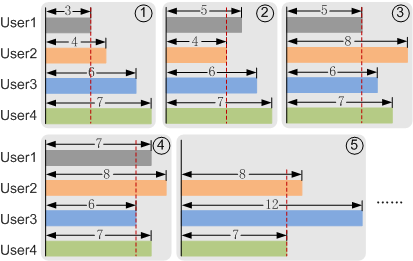Airtime Scheduling
Overview
Airtime scheduling schedules channel resources based on the channel occupation time of users connected to the same radio. Each user is assigned equal time to occupy the channel, ensuring fairness in channel usage.
On a WLAN, the physical layer rates of users differ greatly. This is due to different radio modes, supported by either the terminals or the radio environment where the terminals reside. If users with lower physical layer rates occupy wireless channels for a long period, user experience of the entire WLAN is affected. When airtime scheduling is enabled, users on the WLAN occupy the wireless channel equally. This improves the overall user experience when high- and low-speed users are connected at the same time.
Principles
- Collects statistics on the time within which each user occupies a wireless channel to send packets on the same radio.
- Calculates the total sum of time that each user occupies the wireless channel.
- Sequences the STAs in ascending order of channel occupation time.
- Inserts new users to specified positions according to their wireless channel occupation time. In traditional scheduling modes, new users are placed at the end of the user queue.
- Checks whether a user continues to send data after they finish sending the first queue of data. If yes, they are inserted into the queue according to their wireless channel occupation time. The device preferentially schedules channel resources for the user with the shortest channel occupation time. If the user does not continue to send data, the device directly schedules channel resources for the second user.
- After airtime scheduling is enabled, the device collects the channel occupation time of the four users. The channel occupation times of User1, User2, User3, and User4 become 3, 4, 6, and 7 respectively. User1 occupies the channel for the shortest time. Therefore, the device allocates channel resources to User1 first.
- It takes a time of 2 for User1 to finish a round of data transmission. The channel occupation time of User1 increases to 5. The channel occupation times of User1, User2, User3, and User4 become 5, 4, 6, and 7 respectively. User2 occupies the channel for the shortest time. Therefore, the data of User2 is preferentially transmitted.
- It takes a time of 4 for User2 to finish a round of data transmission. The channel occupation time of User2 increases to 8. The channel occupation times of User1, User2, User3, and User4 become 5, 8, 6, and 7 respectively. User1 occupies the channel for the shortest time. Therefore, the device preferentially schedules channel resources for User1.
- If User1 finishes all data transmissions, the device only collects the channel occupation time of the remaining users. The channel occupation times of User2, User3, and User 4 are 8, 6, and 7 respectively. User3 occupies the channel for the shortest time. Therefore, the data of User3 is preferentially transmitted.
- It takes a time of 6 for User3 to finish a round of data transmission. The channel occupation time of User3 increases to 12. Channel occupation time of User2, User3, and User4 becomes 8, 12, and 7 respectively. User4 occupies the channel for the shortest time. Therefore, channel resources are preferentially scheduled for User4.
To prevent that the first access users fail to occupy the wireless channels to transmit data, the device periodically clears all users' wireless channel occupation time. In this way, all access users have the same occupation weight.

